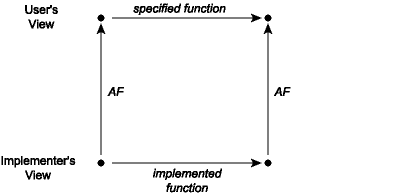Commutative Diagrams
Using the abstraction function, we can now talk about what it means for an implementation of an abstraction to be correct. It is correct exactly when every operation that takes place in the concrete space makes sense when mapped by the abstraction function into the abstract space. This can be visualized as a commutative diagram:

A commutative diagram means that if we take the two paths around the diagram, we have to get to the same place. Suppose that we start from a concrete value and apply the actual implementation of some operation to it to obtain a new concrete value or values. When viewed abstractly, a concrete result should be an abstract value that is a possible result of applying the function as described in its specification to the abstract view of the actual inputs. For example, consider the union function from the implementation of sets as lists with repeated elements covered last time. When this function is applied to the concrete pair [1; 3], [2; 2], it corresponds to the lower-left corner of the diagram. The result of this operation is the list [2; 2; 1; 3], whose corresponding abstract value is the list {1, 2, 3}. Note that if we apply the abstraction function AF to the input lists [1; 3] and [2; 2], we have the sets {1, 3} and {2}. The commutative diagram requires that in this instance the union of {1, 3} and {2} is {1, 2, 3}, which is of course true.